Global Plant-Based Travel: A Comprehensive Guide for Dietary-Conscious Travelers
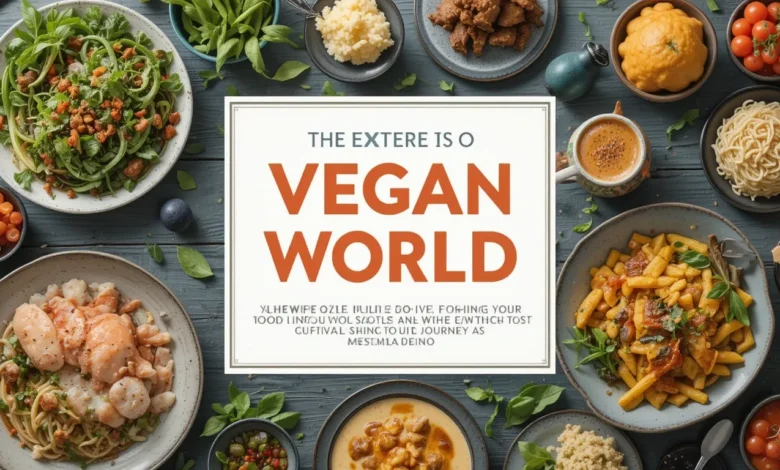
Introduction
Navigating international cuisine with dietary restrictions can transform a dream vacation into a stressful experience. This comprehensive guide helps you explore the world while honoring your dietary needs and food values. From vegan essentials to cultural etiquette, we’ll ensure your culinary journey is as memorable as your destinations.
Vegan Travel Essentials: Preparing for Plant-Based Adventures
Creating memorable travel experiences as a vegan requires preparation, cultural understanding, and adaptability. Here’s how to make your plant-based journey seamless and enjoyable.
Research Destination Vegan-Friendliness
Before booking your tickets, research how vegan-friendly your destination is. Some cities are vegan paradises, while others might present challenges.
Most Vegan-Friendly Global Destinations:
- Berlin, Germany: Europe’s vegan capital with over 100 fully vegan restaurants
- Chiang Mai, Thailand: Abundant vegetarian Buddhist cuisine with clear labeling
- Portland, Oregon: Pioneer in plant-based dining with innovative vegan establishments
- Tel Aviv, Israel: Mediterranean vegan haven with hummus, falafel, and innovative dishes
- London, UK: Home to hundreds of vegan establishments across diverse cuisines
Emerging Vegan Destinations:
- Warsaw, Poland: Rapidly growing vegan scene with over 50 plant-based restaurants
- Mexico City, Mexico: Traditional plant-based options plus modern vegan innovations
- Seoul, South Korea: Buddhist temple cuisine and modernized vegan Korean dishes
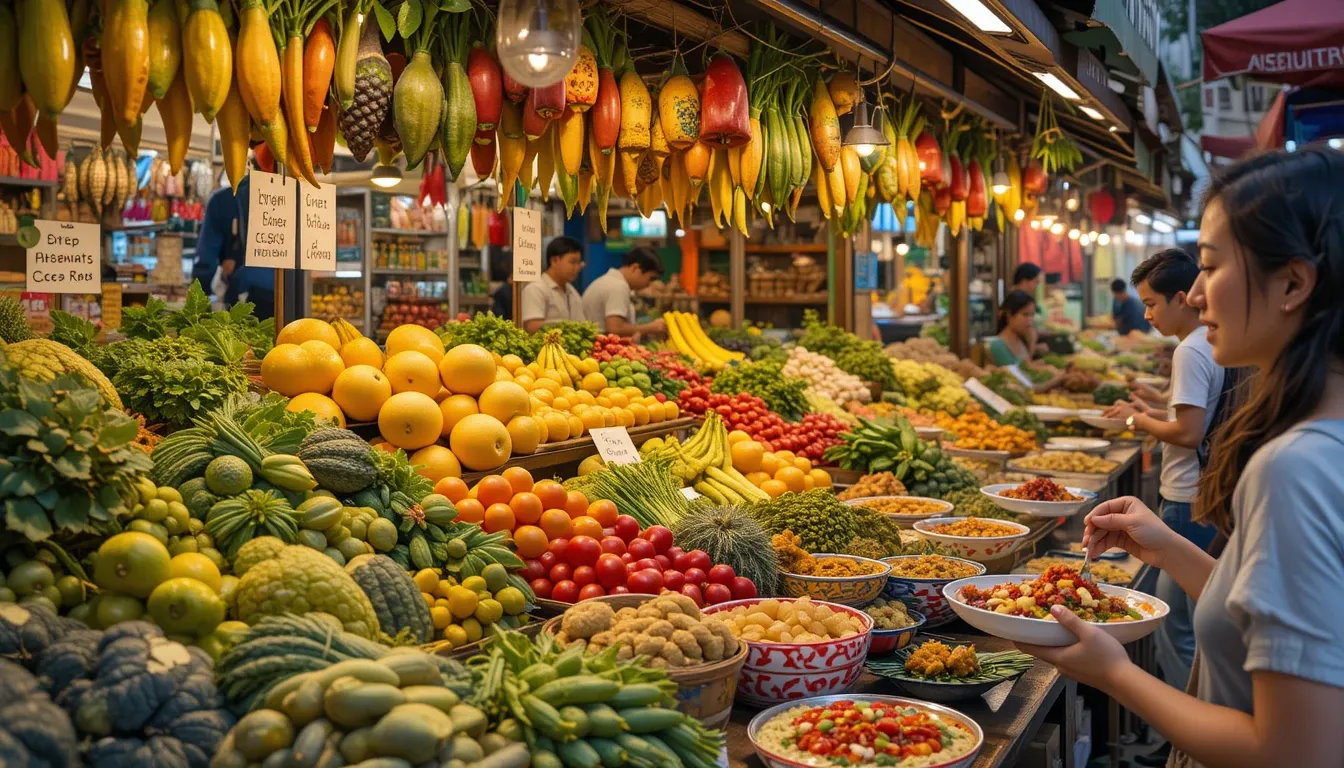
“Vibrant vegan food market in Chiang Mai showcasing local plant-based Thai specialties for travelers”
Essential Vegan Travel Apps and Tools
Leverage technology to find vegan options wherever your journey takes you:
- HappyCow: The essential global vegan restaurant finder available in 180+ countries
- Google Translate: Download language packs to explain dietary needs offline
- Vegvisits: Find vegan-friendly accommodations and hosts worldwide
- Air Vegan: Rate and find vegan options at airports globally
Packing Vegan Travel Staples
Even in vegan-friendly destinations, these packable essentials ensure you’re never without options:
- Nutritional yeast packets (adds protein and cheesy flavor to any dish)
- Shelf-stable plant milk (for coffee or emergency breakfast)
- Protein bars with clean ingredients
- Reusable cutlery and food containers (reduces waste while allowing you to carry leftovers)
- Portable blender for hotel room smoothies
For longer trips, consider booking accommodations with kitchen access to prepare simple meals when restaurant options are limited.
Communicating Dietary Needs Across Languages
When traveling in regions where veganism isn’t well-understood, clear communication becomes essential:
- Carry vegan passport cards with your dietary requirements translated into multiple languages
- Learn key phrases like “I don’t eat meat, dairy, eggs, or fish” in your destination’s language
- Understand the local words for common animal ingredients
- Use visual communication when language barriers exist (pointing to ingredients you can eat)
Gluten-Free Europe Guide: Navigating Continental Cuisine Safely
Europe offers incredible cuisine and history, but navigating its bread-centric food culture requires planning for gluten-free travelers.
Gluten-Free Friendly European Countries
Some European countries understand gluten-free needs better than others:
Italy: Surprisingly accommodating despite its pasta culture. Italian celiac association has certified thousands of restaurants nationwide, and pharmacies carry gluten-free products.
Finland: Nearly 2% of Finns have celiac disease, making gluten-free options widely available in restaurants and grocery stores.
Ireland: Strong celiac awareness with clear labeling laws and dedicated gluten-free menus in many establishments.
UK: Comprehensive allergen labeling and chain restaurants with detailed gluten-free menus.
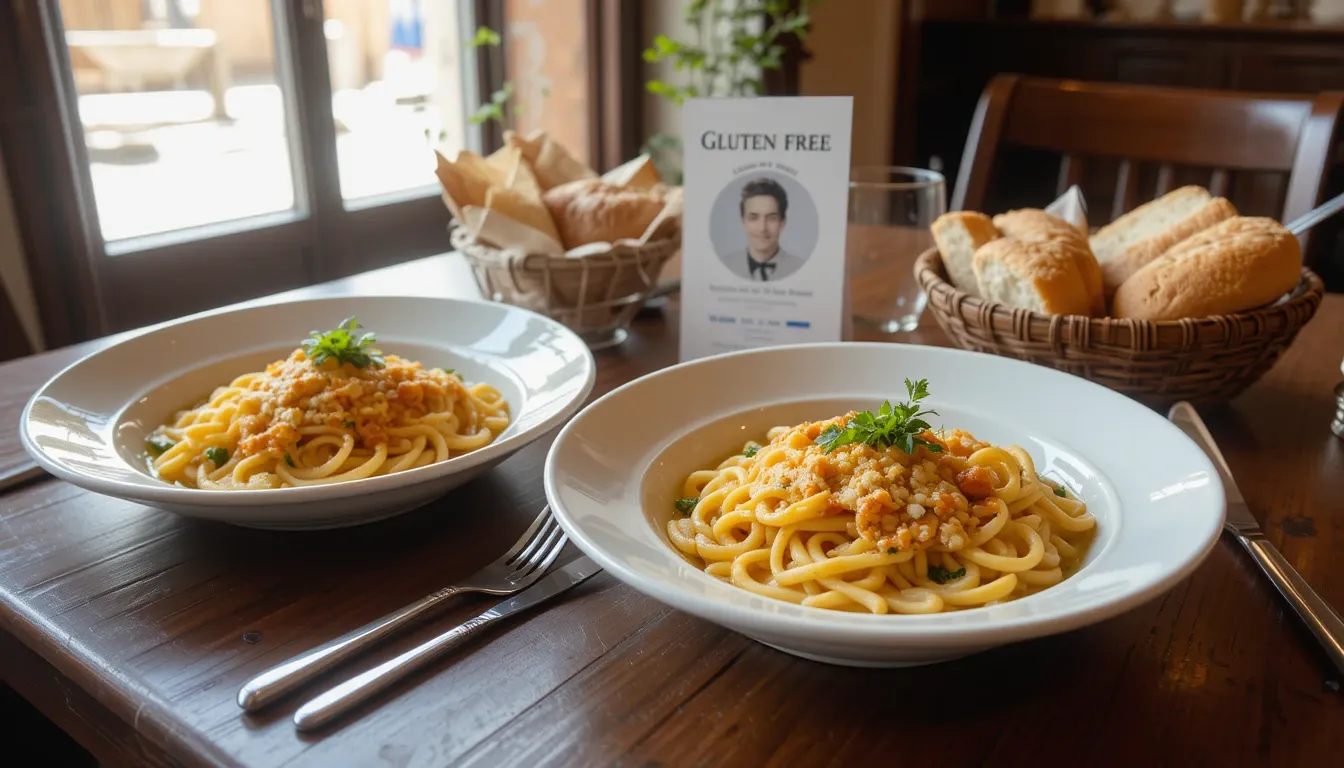
“Certified gluten-free Italian restaurant serving safe pasta and bread alternatives in Rome”
Gluten-Free Travel Cards and Apps for Europe
Essential tools for safe European dining:
- Celiac Travel Cards: Download country-specific cards explaining celiac disease
- Find Me Gluten Free: Traveler-reviewed restaurant database covering European cities
- Gluten Free Roads: European-focused restaurant finder with stringent verification
- Google Translate: Download language packs to scan menus for gluten-containing ingredients
Navigating Traditional European Cuisines
Traditional European cuisine often centers around wheat-based products, but each country offers naturally gluten-free specialties:
France: Despite its baguette fame, enjoy:
- Socca (chickpea flour crepes)
- Macarons (naturally gluten-free)
- Salade Niçoise (specify no croutons)
Germany: Beyond pretzels and beer, try:
- Kartoffelpuffer (potato pancakes)
- Rinderrouladen (beef rolls with gluten-free gravy)
- Dedicated gluten-free beer brands
Spain: Perfect for celiacs with:
- Tortilla Española (potato omelette)
- Paella (verify stock ingredients)
- Legally required allergen menus in all restaurants
European Supermarket Gluten-Free Finds
European grocery stores often have extensive gluten-free sections:
- Carrefour (France): Look for “sans gluten” products
- Tesco (UK): Extensive “Free From” range
- Mercadona (Spain): “Sin Gluten” section with affordable options
- REWE (Germany): “Ohne Gluten” products including breads and pastries
Learn more about navigating food allergies during international travel
Cultural Etiquette Tips: Respecting Food Customs While Maintaining Dietary Needs
Balancing personal dietary requirements with cultural respect can be challenging. These strategies help you navigate social situations with grace.
Understanding Food’s Cultural Significance
In many cultures, food represents more than nutrition it’s about community, tradition, and hospitality. Before declining dishes, understand their importance:
- In Mediterranean cultures, sharing food symbolizes friendship and community
- Throughout Asia, accepting food shows respect for the host
- In Middle Eastern cultures, refusing hospitality can be perceived as rejection
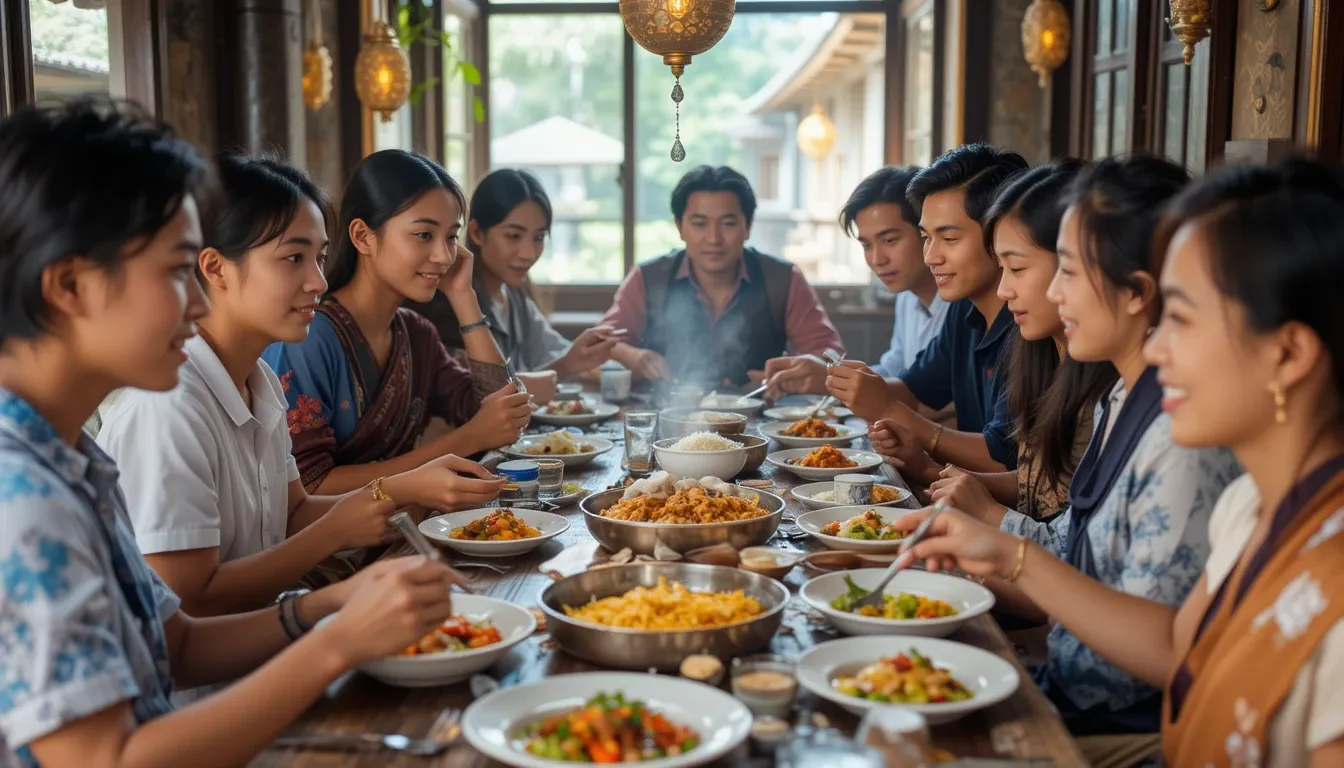
“Travelers and locals sharing traditional cuisine while respectfully accommodating different dietary needs”
Communicating Restrictions Respectfully
When declining food for dietary reasons:
- Express genuine appreciation for the offer
- Explain restrictions as health requirements rather than preferences when appropriate
- Learn phrases like “It looks delicious, but unfortunately I have a medical condition”
- When possible, ask about ingredients before automatically refusing
Participating in Food Rituals Within Restrictions
Find creative ways to participate in food-centered cultural experiences:
- Offer to prepare a traditional dish adapted to your needs
- Focus on components of meals you can enjoy
- Participate in preparation even if you can’t consume the result
- Express interest in learning about traditional cooking techniques
Cultural Food Practices by Region
East Asia:
- Communal dining is common request separate serving utensils
- In Japan and Korea, vegetable dishes may contain fish stock or seafood extracts
- In China, explain dietary needs to the host rather than servers
Middle East:
- Refusing offered food can be considered impolite accept small portions
- Explain restrictions before arriving at gatherings
- Many traditional dishes are naturally vegan or gluten-free
South America:
- Meat often represents prosperity and hospitality
- Frame dietary choices as health requirements rather than preferences
- Offer to bring a dish to share that meets your needs
Sustainable Seafood Guide: Ethical Ocean-to-Table Dining
For travelers who include seafood in their diet, making sustainable choices supports ocean health and local fishing communities while enhancing your culinary experience.
Understanding Sustainable Seafood Certification
Reliable certification programs help identify sustainable seafood globally:
- Marine Stewardship Council (MSC): Blue label indicates sustainable wild-caught seafood
- Aquaculture Stewardship Council (ASC): Certifies responsibly farmed seafood
- Seafood Watch: Color-coded system (green, yellow, red) for sustainability levels
These certifications consider:
- Fishing methods that minimize bycatch
- Population health of target species
- Ecosystem impacts
- Management practices
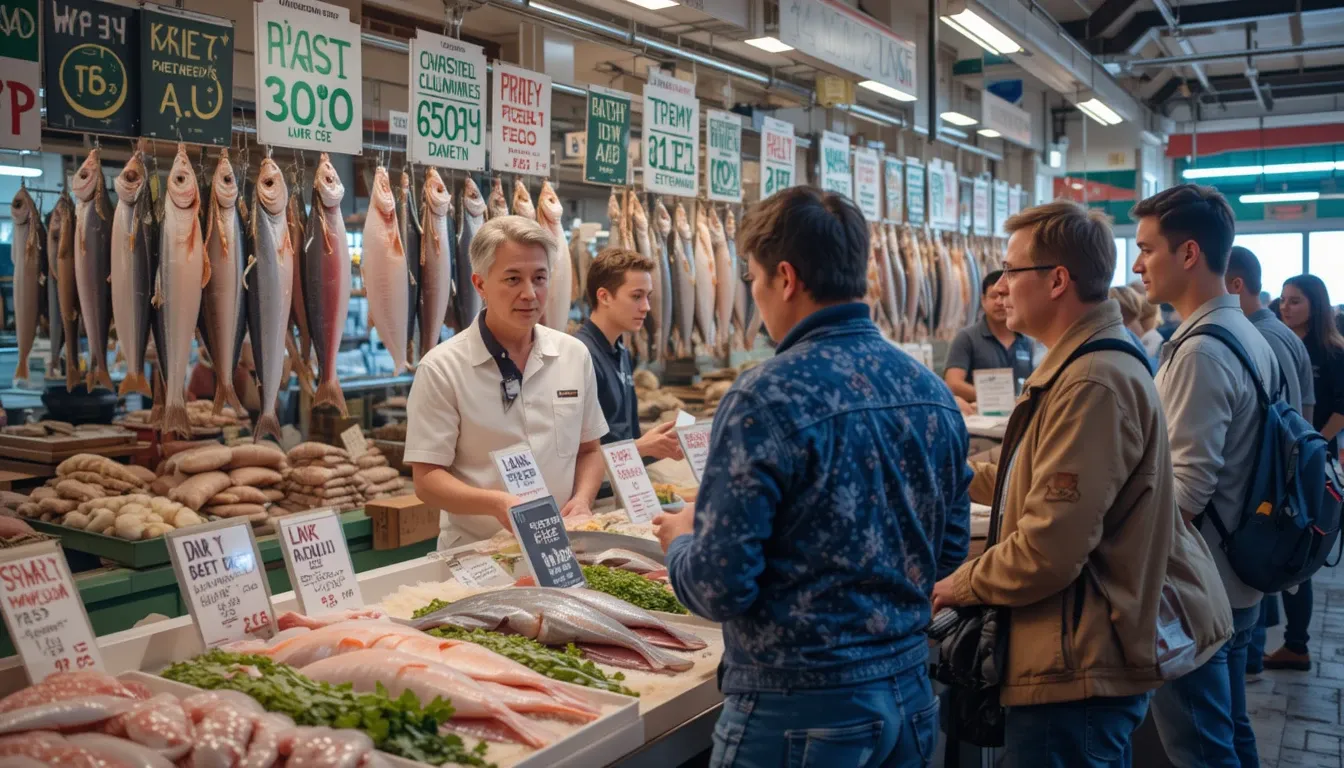
“Sustainable seafood market featuring MSC-certified options with fishmonger educating travelers about responsible choices”
Regional Sustainable Seafood Choices
Different regions offer varying sustainable seafood options based on local ecosystems:
Mediterranean:
- Sardines and anchovies (small, fast-reproducing species)
- Farmed mussels and oysters (filter feeders requiring no feed input)
- Line-caught amberjack
North America:
- Alaska wild salmon (MSC-certified)
- Farmed rainbow trout
- Pacific albacore tuna (pole-caught)
Southeast Asia:
- ASC-certified farmed tilapia
- Line-caught yellowfin tuna (when verified sustainable)
- Traditional fishing communities practicing time-tested sustainable methods
Avoiding Endangered and Overfished Species
Regardless of location, these seafood options generally face sustainability challenges:
- Bluefin tuna
- Orange roughy
- Most sharks and rays
- Imported shrimp (often associated with mangrove destruction)
- Unverified “specialty” fish (often subject to illegal fishing)
Seafood and Cultural Traditions
In many coastal communities, seafood represents cultural heritage and identity. When participating in local culinary traditions:
- Choose establishments sourcing from local small-scale fishers
- Ask about traditional sustainable fishing methods
- Support community-supported fishery programs
- Learn about historical fishing practices that maintained ecosystems for centuries
For in-depth information on sustainable seafood choices worldwide, visit the Marine Conservation Society’s Good Fish Guide.
Global Foodie Index: World’s Best Culinary Destinations for Dietary-Conscious Travelers
Our Global Foodie Index ranks destinations based on their ability to accommodate dietary restrictions while offering exceptional culinary experiences.
Top Plant-Based Culinary Destinations
These destinations excel in plant-based cuisine through tradition or innovation:
Kyoto, Japan: Temple cuisine (shojin ryori) offers meticulously prepared vegan meals with centuries of tradition behind each dish.
Tel Aviv, Israel: Mediterranean climate produces exceptional fresh produce, creating a vibrant vegan scene with unique Israeli innovations.
Portland, Oregon: Pioneer in plant-based dining with food cart pods, upscale restaurants, and innovative vegan products.
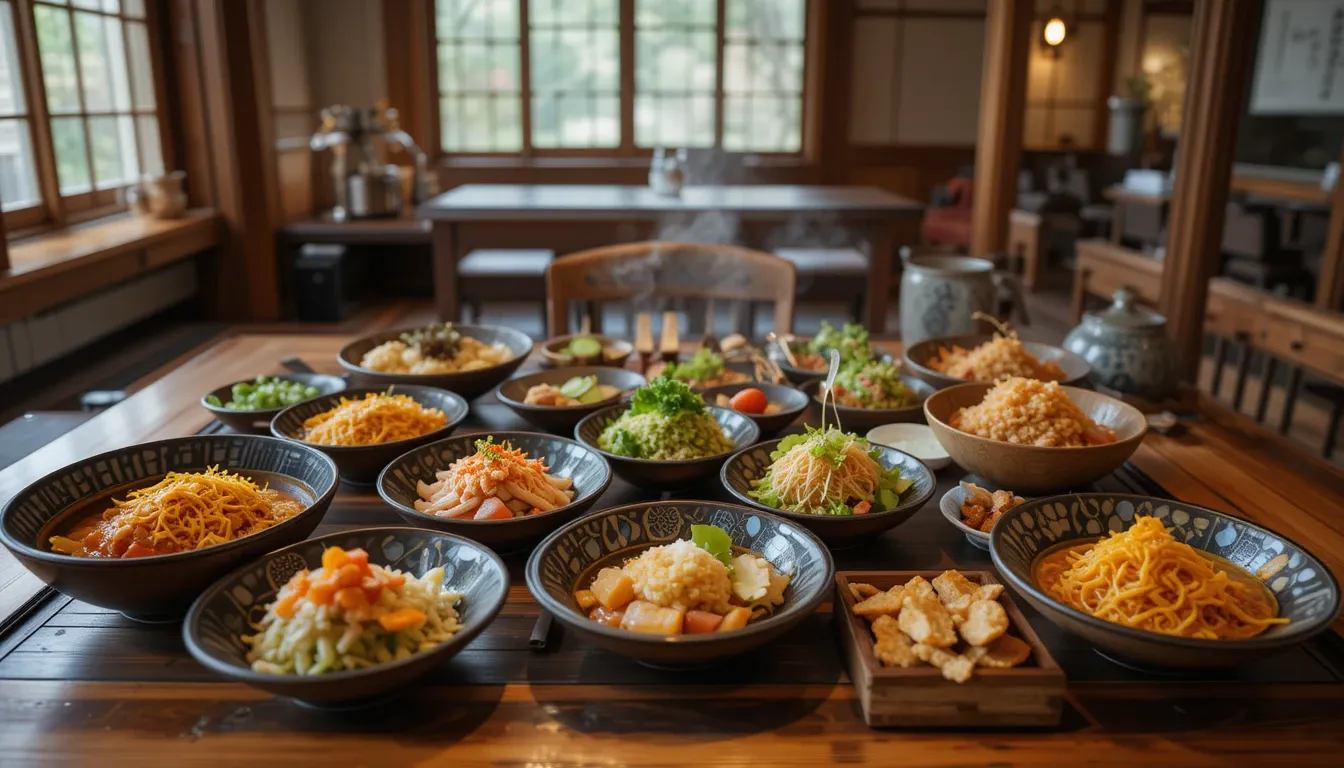
“Traditional Japanese shojin ryori vegan temple cuisine in Kyoto featuring seasonal plant-based dishes”
Best Gluten-Free Foodie Destinations
These locations combine gluten-free accessibility with exceptional culinary experiences:
Vietnam: Rice-based cuisine features naturally gluten-free dishes like pho, fresh spring rolls, and rice noodle specialties.
Mexico City, Mexico: Corn-based traditional cuisine offers exceptional gluten-free options, from street tacos to haute cuisine.
Melbourne, Australia: Strong allergen awareness combined with innovative Pacific Rim cuisine creates a gluten-free paradise.
Most Innovative Food Scenes for Dietary Restrictions
These destinations are pioneering inclusive dining regardless of restrictions:
Copenhagen, Denmark: New Nordic cuisine emphasizes pure ingredients and innovative preparations adaptable to any restriction.
Singapore: Diverse culinary influences combine with forward-thinking chefs to create options for every dietary need.
Los Angeles, USA: Cutting-edge restaurants cater to health-conscious diners with creative solutions for dietary restrictions.
Rising Star Culinary Destinations
Watch these emerging foodie destinations with excellent dietary accommodation:
Lisbon, Portugal: Embracing traditional dishes adaptable to modern dietary needs Taipei, Taiwan: Buddhist influence creates numerous vegetarian options while modern chefs innovate with classic techniques Medellín, Colombia: Tropical fruits and vegetables star in adaptable cuisine
Creating Memorable Food Experiences Within Dietary Boundaries
Dietary restrictions don’t have to limit your culinary adventures. These strategies help you embrace global food culture while honoring your needs.
Cooking Classes and Food Tours
Participatory food experiences can often be adapted:
- Request dietary accommodations when booking cooking classes
- Arrange private food tours with advance notice of restrictions
- Seek out specialized cooking schools catering to dietary needs
- Consider market tours focusing on ingredients rather than prepared foods
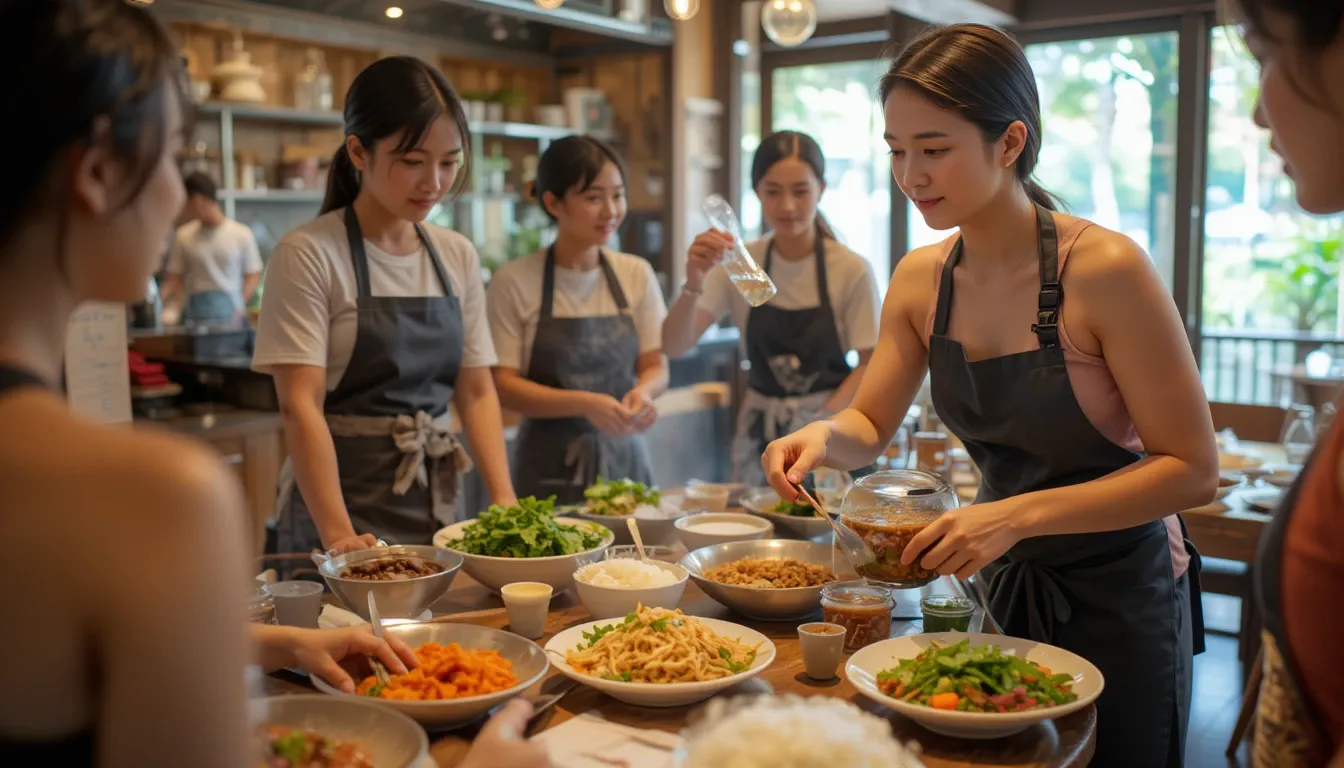
“Thai cooking instructor teaching travelers how to prepare vegan pad thai using traditional techniques”
Finding Authentic Experiences Within Restrictions
Connect with local food culture while respecting your dietary boundaries:
- Research traditionally acceptable dishes for your dietary needs
- Connect with local dietary-conscious communities through social media
- Visit markets and street food areas during less busy times for personalized service
- Learn to identify safe ingredients in unfamiliar cuisine
Building Positive Relationships With Food Vendors
Creating connections with local food providers improves your experience:
- Learn basic food vocabulary in the local language
- Show genuine interest in traditional preparation methods
- Return to establishments that accommodate your needs
- Express sincere gratitude for accommodations
Discover more ways to connect with local food culture during your travels
Conclusion:
Embracing Global Cuisine Without Compromising Your Needs
Traveling with dietary restrictions or preferences doesn’t mean missing out on authentic culinary experiences. By implementing vegan travel essentials, understanding gluten-free options in Europe, respecting cultural etiquette, choosing sustainable seafood, and using our Global Foodie Index, you can transform potential limitations into opportunities for deeper cultural connection.
The key to successful dietary-conscious travel lies in preparation, communication, and maintaining a spirit of adventure.
Remember that every dietary restriction creates an opportunity to explore different aspects of a culture’s cuisine ones that other travelers might overlook. Whether you’re enjoying temple cuisine in Kyoto, gluten-free street tacos in Mexico City, or sustainable seafood in a Mediterranean fishing village, your mindful approach to food will enrich your travel experience while supporting your health and values.